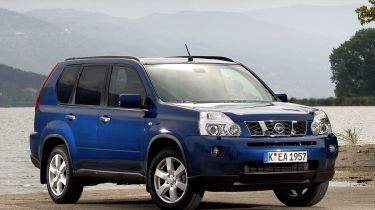Nissan X-Trail
Practical and reasonably capable on and off-road, but the Nissan X-Trail brings nothing new to the compact 4x4 market

Despite being all-new, the latest X-Trail is surprisingly similar to its predecessor. It retains the rugged feel and adventurous spirit of the outgoing model, but doesn't offer vast improvements in any one area. While practical, comfortable and reasonably capable on and off-road, the Nissan brings nothing new to the compact 4x4 market - although bettering the already highly competent outgoing car will be enough for many buyers.
From the Ford Focus-sized Qashqai to the unstoppable Patrol off-roader, Nissan has an all-wheel-drive model for every eventuality.
And at the centre of the manufacturer's SUV line-up is the all-new version of the X-Trail. At first glance, it doesn't seem that much different from the car it replaces. Indeed, when it was unveiled at the Geneva Motor Show in March, the latest generation went virtually unnoticed.
Look closer, though, and you will see that every panel is new - as is the platform, which is shared with the Qashqai crossover.
Retaining the rugged style of the original X-Trail was paramount for Nissan's designers, who have made subtle adjustments all-round for a fresher look. A more radical approach has been taken inside, though.
The outgoing variant's trademark knobbly seats and durable dashboard were becoming dated, yet they had a utilitarian feel that the new model lacks. Nissan has deliberately fitted a more upmarket dash, which is perfectly laid out and attractively styled.
Equipment levels are good, with every variant having standard air-con and Bluetooth phone connectivity. The latest X-Trail is even more practical than before, too, with a huge boot featuring a clever two-level floor and 40/20/40-split rear seats.
There will be two petrol and two diesel powerplants to choose from. The entry-level 2.0-litre petrol unit comes from the Qashqai, while the 2.5-litre petrol is a modified version of the current X-Trail's motor. About 90 per cent of UK buyers are expected to go for the diesels, however, and there's a fresh 2.0-litre oil-burner to replace the 2.2, with power outputs of 148bhp or 171bhp.
Our top Aventura-spec car came with Nissan's six-speed automatic transmission, and is one of the few oil-burning self-shifters in this sector. Out on the road, it's soon clear that improving refinement has been a top priority. Although the diesel rattle remains at all speeds - made worse by the auto's sluggish changes - the X-Trail is now a pretty quiet and relaxing long-distance cruiser.
Body control has been improved, too. While it can take time for the driver to gain confidence in the over-assisted steering, at the right speed, the Nissan corners with surprisingly little roll. However, enter a bend too fast and it's apparent from the angle of lean that you are driving an SUV.
The company's own research indicates that a surprising 30 per cent of X-Trails are taken off-roading once a month. As a result, this model is even more competent than its predecessor over rough terrain. A revised version of the maker's four-wheel-drive system, along with fresh hill descent and climb functions, ensure it's more competent than a soft-roader.
So the new X-Trail is indeed better in nearly every way... but it may still go unnoticed. That's because there's nothing revolutionary about the design, which could leave it lacking in vital showroom appeal.
Prices will range from around £19,000 to £25,000 when the new model goes on sale in September.







